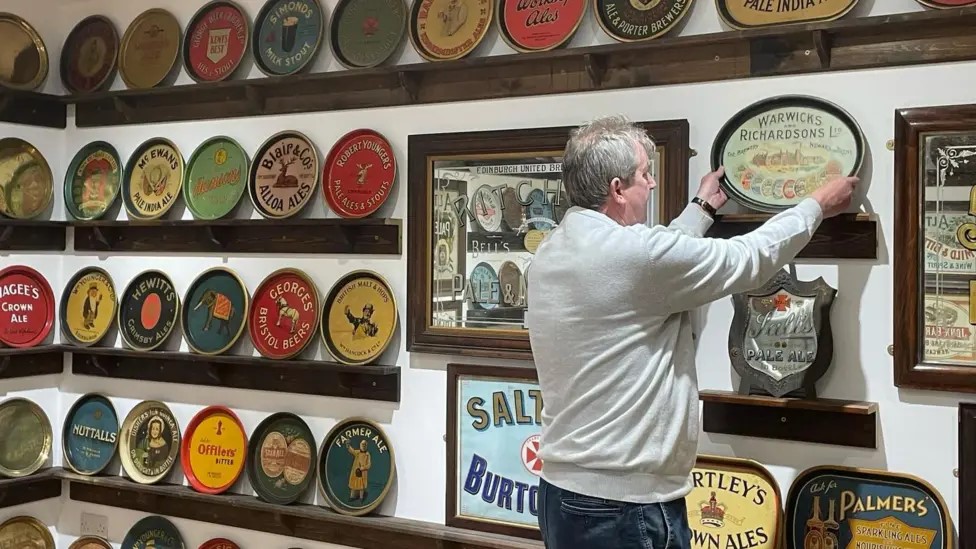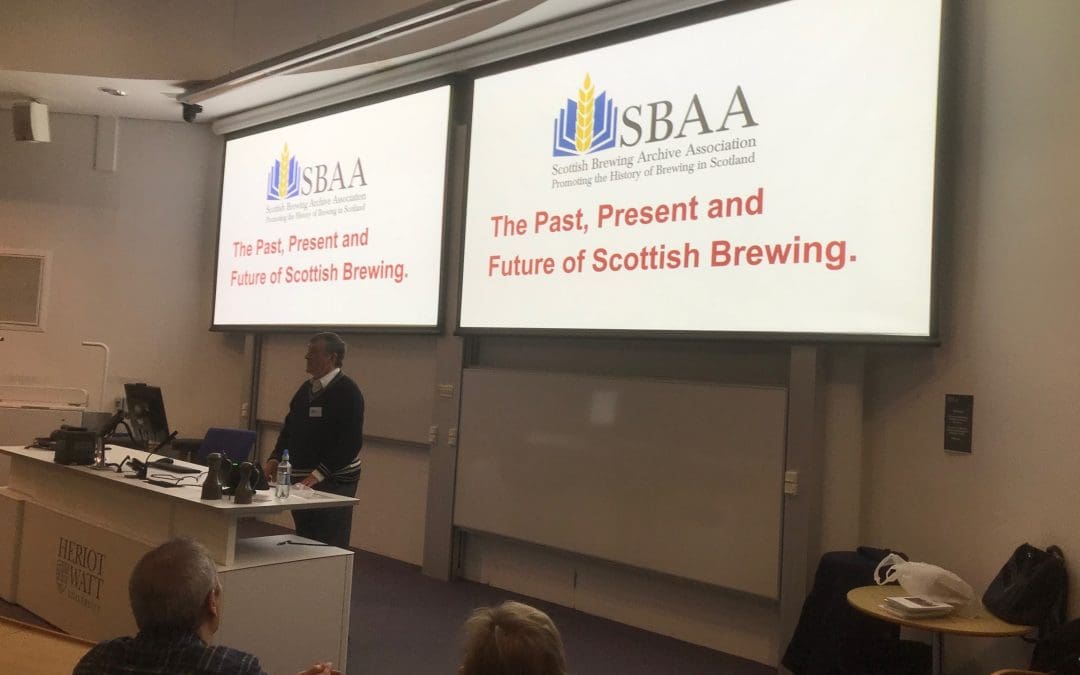“View from the Chair”
It would appear that winter is over and the joys of spring are now with us.
I am pleased to announce that the SBAA have made a donation of £500 to Heriot-Watt University to honour Harvey Milne. The donation is to be awarded to the highest performing student taking the Filtration & Packaging Course, part of the MSc in Brewing & Distilling at ICBD.
This particular course covers the dispense and cellar management for keg and cask beers. This links in with Harvey’s duties during his Cask Marque days, which celebrates its 20th anniversary this year. Please see the Paul Nunny article that covers this.
Events during the year:
It was agreed at the last AGM that we would arrange a visit to the Scottish Brewing Archive at the University of Glasgow. This has been agreed to be on ____ June this year to view a selection of the artefacts.
If you wish to attend please contact John Martin by phone or e-mail for further information.
0131 441 7718
martin.j7@sky.com
Cask Marque and Harvey Milne:
This year marks the 20th anniversary of Cask Marque, and was formed in 1998 to address the void in beer quality control, caused partly by the Government Beer Orders which forced breweries to sell their pubs and as a result had an impact on beer quality, a concern for the brewing industry. As a result four breweries, Adnams, Greene King, Marstons and Morlands set up Cask Marque to address this concern.
Long may it continue to ensure that beers meet the strict beer quality standards.
Harvey Milne who sadly passed away last year was a Cask Marque Quality Management and Training consultant for 16 years and covered the whole of Scotland. As a result it is fitting that Paul Nunny – Director of Cask Marque has prepared the following in honour of Harvey.
We, as an industry, and all his friends and relations are saddened by the loss of Harvey Milne. Like the pubs he visited for Cask Marque he became a friend as well as a business associate. Originally Harvey joined Cask Marque as our Scotland assessor in 2001. He would normally make around 750 visits to pubs a year to assess the quality of their beer. He was also our trainer delivering the BII Cellar Management Courses which he regularly held at Caledonian Brewery as well as undertaking 1-2-1 training in pub cellars.
Covering the whole of Scotland and Northern Ireland he would frequently go off for 2 or 3 days with Lesley, his wife and send postcards to the office of pubs and places he had visited. A difficult person to replace.
Harvey, was one of our 45 assessors who cover the country carrying out over 22,000 pub visits each year. We now have 10,094 pubs with the Cask Marque award and in a recent YouGov survey found that 77% of cask ale drinkers now recognise the plaque and 67% know it is a quality symbol. Along with Harvey we also have 10 other trainers and are now the largest provider of cellar management training in the UK.
It is people like Harvey who have made Cask Marque the success it is and he has left a legacy in Scotland, which we must build on.
Paul Nunny
Women in Brewing Beer Fair Showcases Scottish Beer:
With over 100 new breweries in the last ten years, there’s a lot of energy in the Scottish beer industry. Quality, innovation and collaboration are flourishing as a result of this rapid growth.
Timed to coincide with International Women’s Day, the first “Women in Brewing Beer Fair” was hosted by the Edinburgh University Student’s Union on the 8th March at Teviot Row house. It shone a spotlight on the women driving the Scottish beer industry forward into a new golden age.
Jo Stewart, an early pioneer of craft beer in Scotland and co-founder of Stewart Brewing, observes that the “industry has certainly come a long way in the 14 years we have been brewing.”
It’s a sentiment Jan Moran of Ferry Brewery agrees with noting, “consumer tastes have changed; they want quality, variety, interesting brews and there are many opportunities to try as many styles from as many breweries than ever before.”
Shannon McFarlane of Tempest Brewing Co adds “you’re also starting to see a more diverse audience for craft beer, people are more open to it and willing to try new things, I think in part to how much of an emphasis the beer industry puts on education and openness.”
To meet demand breweries are collaborating with each other to produce special edition beers. They are also reaching out to the likes of Amy Rankine of Hipsters & Hobos, a foraging expert who’s worked with the likes of Cross Borders Brewing Company and Campervan Brewery to produce beers brewed with locally picked ingredients.
It’s a development that excites Dani Mountain, a social media expert working with microbreweries. She’s looking forward to seeing Scottish brewers “take more chances with their beers and experiment with the fantastic resources the country has to offer.”
The advances in Scottish beer combined with the country’s existing global reputation for food and drink is opening up a new opportunity.
“The most exciting thing…as Scottish beer gains popularity in international markets is that it will bring more tourism to Scotland as people travel here from all over the world to try incredible Scottish beers” says Jenny Watt of ScotBeer Tours.
Sara Robertson
Polesden Lassey and the McEwan’s connection:
Last year I was invited by the National Trust to visit Polesden Lacey, a mansion near Dorking, about 25 miles from central London.
I had expressed an interest in visiting Polesden Lacey with the McEwan’s Beer Co. who put me in touch with the person from the National Trust who was researching William McEwan the famous brewer.
Polesden Lacey was the country retreat used for entertaining by William McEwan’s daughter Margaret and was gifted to her and her husband Ronald Greville by her father, who had previously made his fortune from beer.
William McEwan lived in Charles Street in Mayfair, London and his daughter and husband lived nearby just a few doors away.
Margaret Greville became a socialite and hosted many elaborate dinner parties and invited the most powerful and influential people of the age including royalty from the UK and abroad. This included King Edward VII. In fact following the marriage of Duke of York and Elizabeth Bowes-Lyon (the future King and Queen) they spent their honeymoon at Polesden Lacey.
The contents of Polesden Lacey have museum quality treasures, which include fine examples of Dutch, Italian and British paintings, Chinese and European ceramics, 17th and 18th century miniatures, and silver and objets d’art.
When Margaret died in 1942 she left Polesden Lacey to the National Trust.
Polesden Lacey looks a very grand building from the outside, however the interior was more than grand and best described when I say it was like a mini Buckingham Palace. During the guided tour I imagined what life must have been like, especially when guests were arriving for diner parties.
Polesden Lacey was not only opulent but a home of grandeur due to the wealth of William McEwan. Margaret Greville did say at one time, “I’d rather be a beeress than a peeress”.
If you were ever planning a visit to London or the vicinity I would recommend that you visit Polesden Lacey. Give yourself a full day for a tour of the home and a walk in the gardens and the large estate. You can recharge your batteries afterwards with a bite to eat in the restaurant or indulge yourself in the shop where you can buy a bottle of McEwans Export.
John Martin


